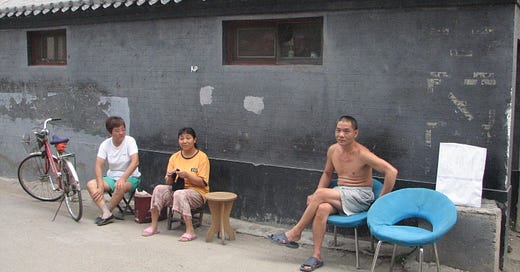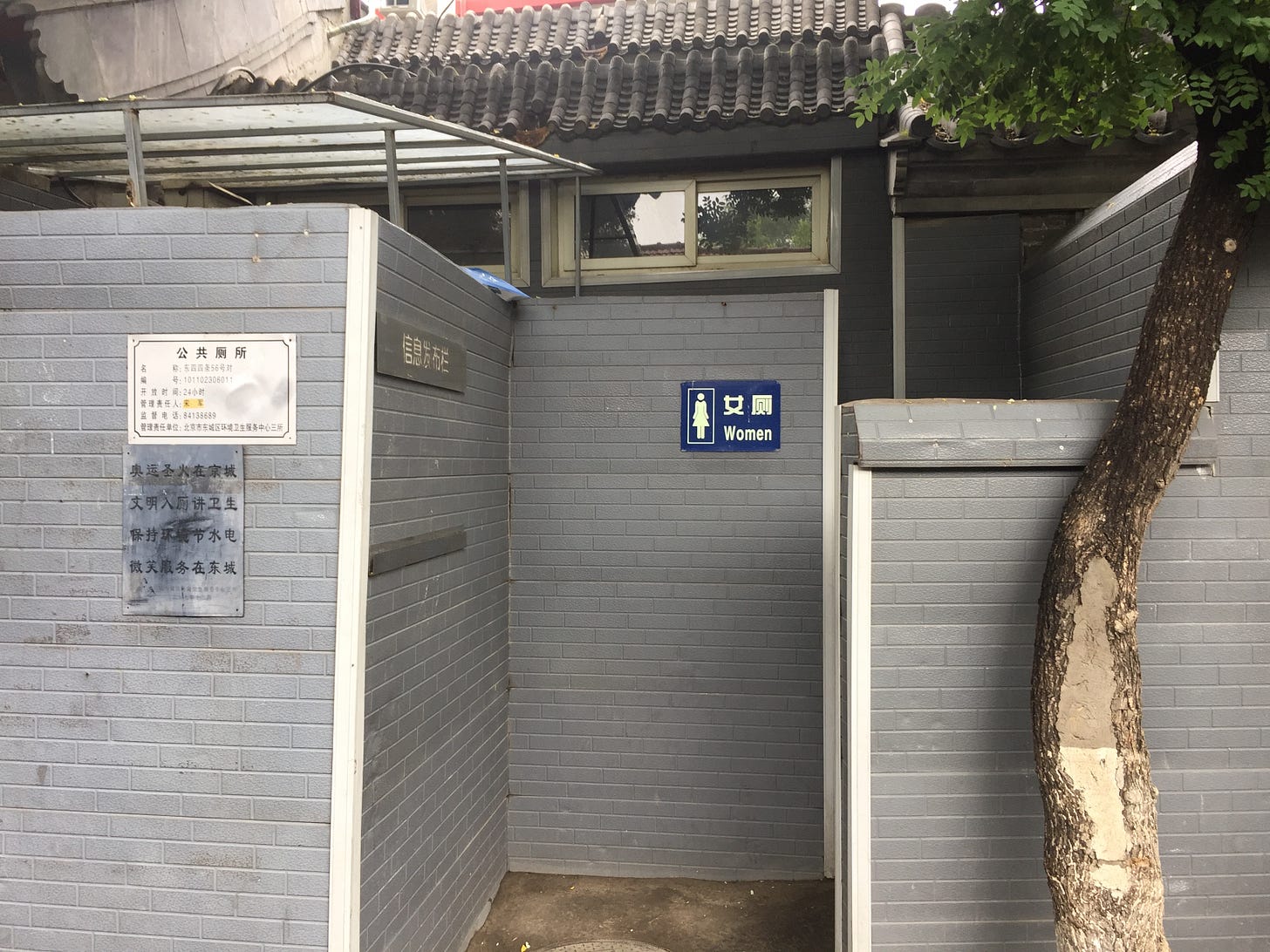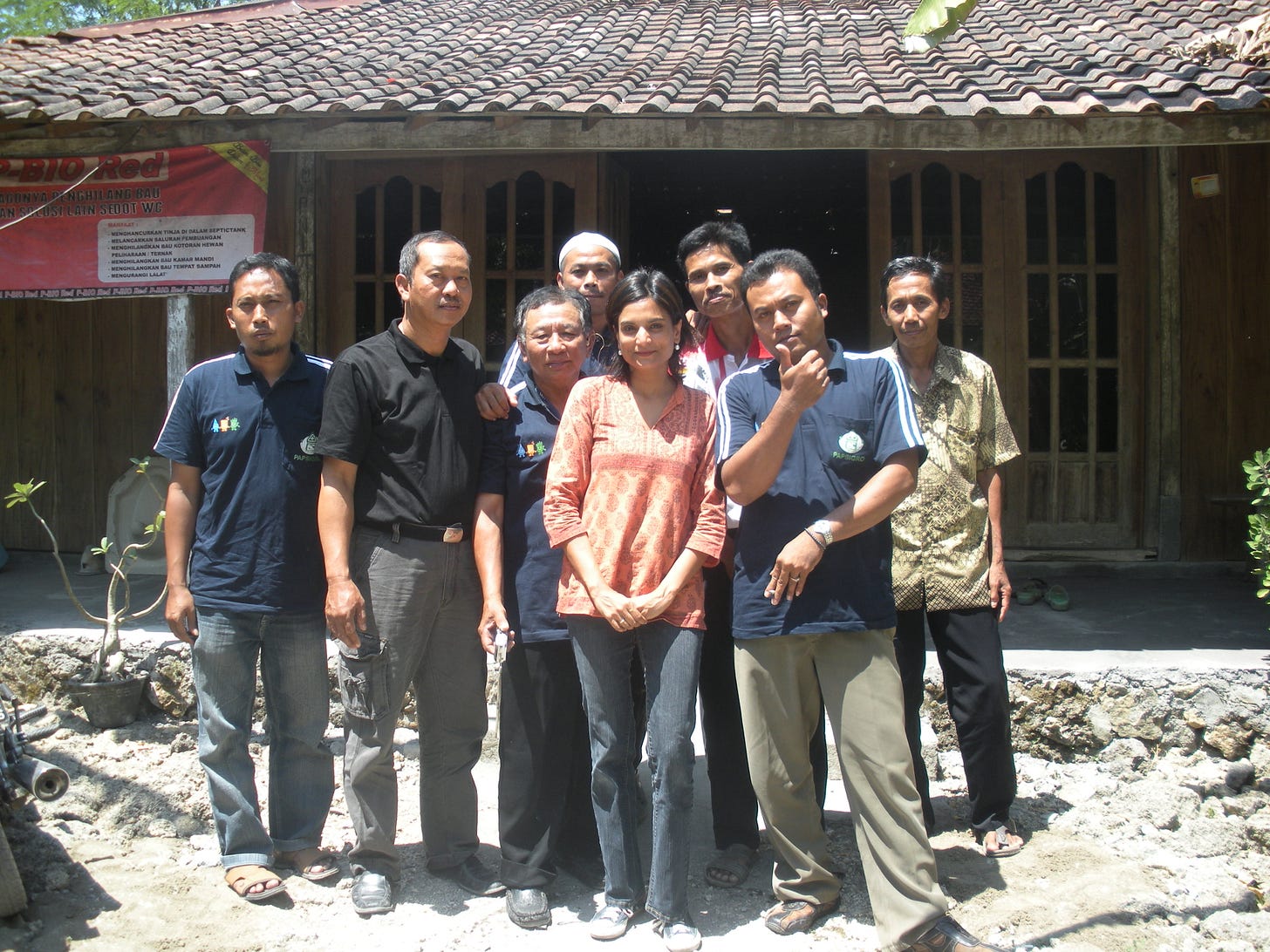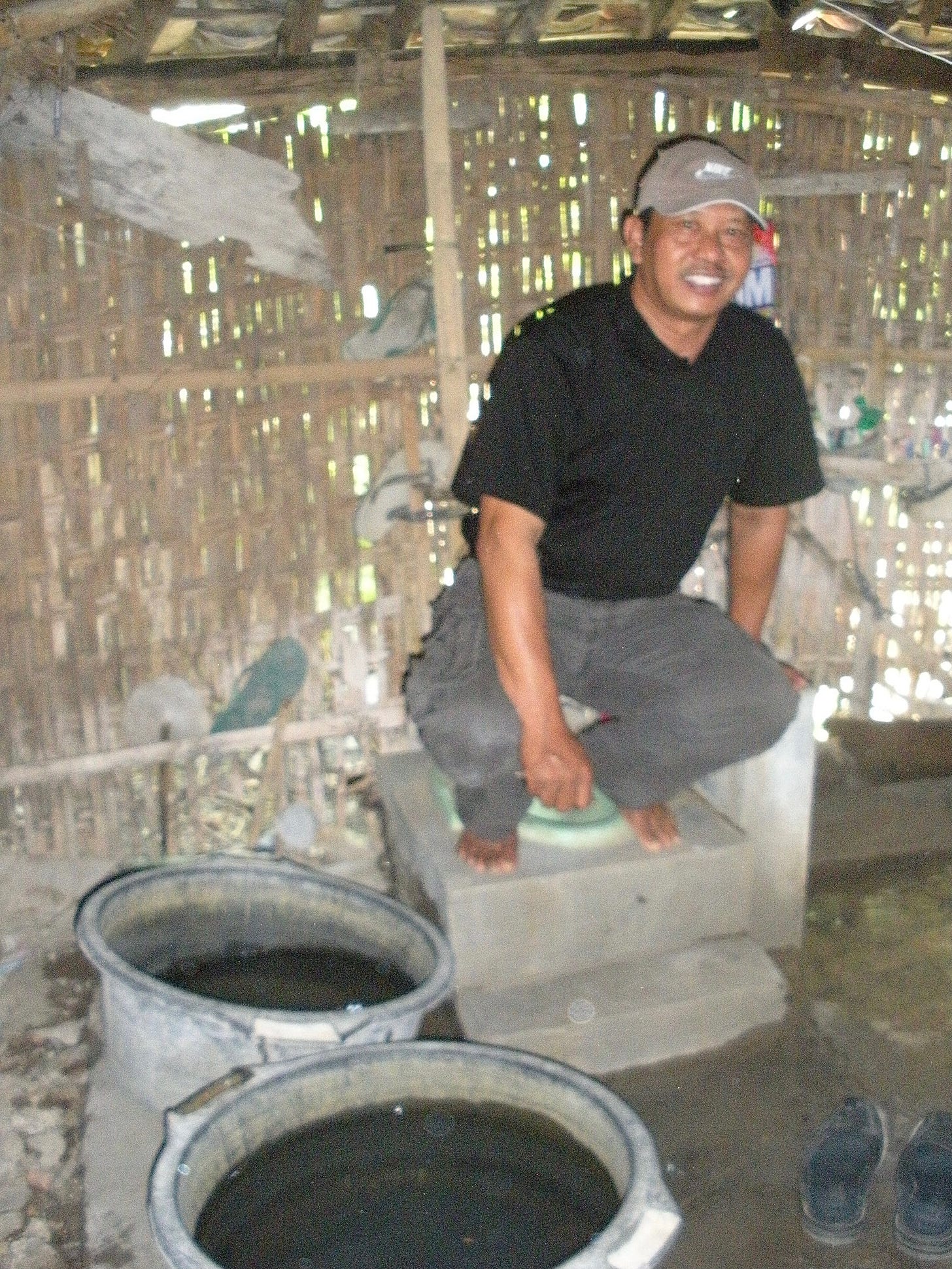I think a lot about toilets, a preoccupation, I hasten to add, that is more sociological than scatological. For it is in its public toilets that a nation bares its buttocks, or the secrets it otherwise keeps under the wrap of more edifying clothing.
Over the last two decades I’ve written about toilet cleaners in China, followed toilet entrepreneurs around central Indonesia, spent time pondering the inefficiencies of sewage treatment plants in India, and been wowed by the wonders of the objet d’art known as the Japanese toilet.
It was while I was living in a hutong in the old part of Beijing that public toilets first began impinging on my consciousness. This was a presence both olfactory, since I lived directly across from the sole WC for the entire lane, and social, for the toilet was the fulcrum of community life.
In the hutongs cramped quarters forced people to spend much of their lives out on the street, and a paved-over square in front of the toilet was the spot of choice for the neighbours to park their rickety folding chairs and tables. There they would play chess late into the sweltering summer nights, cracking sunflower seeds and jokes, while kids and pet dogs, with names like “old fatty” flitted between their legs.
(My hutong neighbours in Beijing)
The toilet was an unreconstructed relic from China’s Maoist era, during which the communist government expropriated the mansions of noblemen that had once made the hutongs prestigious real estate, and converted them into dormitory-style accommodation for factory workers. The majority of contemporary hutong accommodation (my own home was luckily an exception) lacked private facilities and so public toilets were an indispensable part of the streetscape.
In a drive to give the city a facelift for the Beijing 2008 Olympic Games, municipal authorities began to upgrade many hutong loos into what the local media dubbed “luxurious lavatories,” complete with working flushes, shiny faucets, electric hand dryers and little annexes that served as live-in accommodation for 24-hour toilet cleaner-wardens.
(Entrance of a public toilet in a Beijing hutong)
Much of the ink in the pens of foreign correspondents in China at the time was expended writing about toilets. The non-luxurious variety, with their unpartitioned holes in the floor and lack of running water, had served to highlight how degrading life for many Beijingers remained, even as the city’s new rich lived in the lap of skyscraper-luxury. On the other hand, the new ‘Olympic’ loos illustrated the workings of an authoritarian government set on stage-managing every aspect of its international ‘coming out party’, as the 2008 Games were habitually described.
I too wrote about Beijing toilets, but what interested me was the toilet cleaners. Mahatma Gandhi had identified toilet cleaning as key to revolutionizing society. He’d stressed that true freedom for India would prove elusive without a metamorphosis in its approach to private and public sanitation. I argued that if he were correct in his beliefs, then it was authoritarian China, not democratic India that had in fact achieved self-respect for its citizens.
Yu Bao Ping was the cleaner of a loo in a nearby hutong to mine. He was originally a rice farmer from Anhui province who had moved to the Chinese capital in early 2004 and landed the toilet cleaning job soon after. I spent a couple of afternoons chatting with him during which he told me how lucky he felt to have got such “good work” in the capital. Compared to the backbreaking labour of farming, the toilet business was a cinch, he’d smiled. It had given him a stable income of around 100 US dollars a month, as well as a place to live and an opportunity to meet people and make friends. ‘Everyone in this neighbourhood comes through these doors,’ Yu had explained.
We shook hands as we said goodbye and he invited me to return for a cup of tea whenever I had the inclination. In my conversations with Beijing toilet cleaners, they’d all admitted that scrubbing commodes was not a stigma-free job; that there were people who were revolted by it. But at this point in the conversation many of the cleaners became misty eyed and brought up the name, Shi Chuanxiang. “You know,” they would say, sniffling, “he gives me courage.”
The fact was I didn’t know, but because this was early-twenty first century China, I did have Google (the search engine is currently blocked in the Chinese mainland) and was able to look up this gentleman who was obviously an inspirational figure for the Chinese sanitation community. I learned that Shi was one of the ‘model workers’ of communist folklore. Having spent more than forty years shoveling and carrying human refuse, he was chosen in 1959 from the ranks of the working class by the government, and feted as an example for society to emulate. His story was still compulsory reading in elementary schools during the time I lived in China (2002-2009).
The fact was that China’s communist revolution had endowed manual labour with relative dignity, albeit at a terrible cost. Over time, I came to believe that the real India-China gap didn’t lie in six-lane highways and shimmering skyscrapers (although there was that), but in the way in which Yu Bao Ping, the toilet cleaner, shook my hand without hesitation. After all there were still people in India liable to rush off to take a bath if they accidentally touched a bhangi, someone belonging to what was traditionally the toilet cleaning and scavenging caste.
Eventually, I did a paper as part of a Reuters Fellowship at Oxford University comparing manual scavengers in India to sanitary workers in China.[1] I figured that caste needed to be placed firmly in the center as a crucial explanatory framework for the divergences between the two countries.
We have now broached an issue that is a mild obsession of mine, but I did promise in my introduction to this newsletter not to bore you, so I’ll move on to….. Indonesia and the flashlight-on-buttocks-wielding, imam, known as the faeces ninja whom I heard of while hanging out with a group of farmer-turned-toilet entrepreneurs in Grobogan, a remote area in central Java.
Indonesia shared India’s public defecation problem, although on a less epic-scale, and its government had mostly followed a similarly wrong-headed sanitation strategy that focused on constructing public toilets as the solution. But, as in India, the simple availability of toilets did little to change the mindset of people used to open defecation. Often, the newly built WCs were used as chicken coops or grain storage, while villagers continued to relieve themselves in the fields. People seemed to prefer to spend their money on “cool” stuff like mobile phones, rather than on commodes. When it came to a resource-allocation tossup between toilets and twitter, the latter usually won out.
Long story short, I was living in Jakarta (I think this was in 2013 or 2014) when I heard that Grobogan, somewhere few people outside Java know of, was an area that had recently been declared ODF. This phrase, an acronym for “open defecation free” gets me excited in the way that more normal people feel about their summer holiday plans. I made some calls, bought a train ticket and before long I was hanging out with the members of the Sanitation Entrepreneurs Association of Grobogan district. These included a watermelon seller, a rice farmer, a mason, a retired government health official and a kiai or local imam. It was a motley crew but they were united by their toilet-fervour.
(With members of the Sanitation Entrepreneurs Association of Grobogan)
They had all been recruited as “change facilitators” by an NGO that was focused on encouraging local mindsets to take a more sanitary bent.
Many of them had decided to put toilets at the center of their livelihoods and swapped farming for WC-design and installation, in addition to working as educators on the issue. One kiai from the nearby village of Sumur Gede was so zealous that he’d been nicknamed the “faeces ninja,” given his penchant for patrolling the bridges that spanned the river in his village at dawn, and directing his torch on any open defecator who crossed his path to shame them into changing their ways.
A key tactic for becoming ODF, my newfound sanitation association friends told me was getting village imams to stress the importance of toilets as part of their Friday sermons. As in China, I was once again struck by the relative lack of stigma attached to sanitation in Indonesia. In India, toilets were bound up with untouchability, and the dichotomy of purity and pollution espoused by Brahminical Hinduism. In Indonesia, the missing “caste” factor was once again key to Grobogan’s ODF transformation.
“We love toilets,” Pak Pardiyanto, an erstwhile watermelon-vendor told me, as he ferried me on his motorbike around the area to look at some of the WCs he’d recently installed in homes. It was because of the money he’d made from becoming a toilet-entrepreneur that he’d been able to afford to get his daughter married, he explained.
My last clear image of that trip is of Pak Pardiyanto squatting on a toilet in an elderly couple’s home, beaming into the camera with a thumbs-up sign. “ODF!” he proclaimed.
(Pak Pardiyanto showing off a toilet he’d just installed)
I promise a post in the not too distant future on Japanese toilets. I actually have an entire chapter on the subject in my forthcoming book, Orienting: An Indian in Japan. But for this week I’ll leave you here with the request to please share this post if you have enjoyed it, and to encourage your friends to subscribe.
Also, I’d love to hear about the lavatorial lowdown in your cities, or any toilet stories/observations you might have. The comments section below is meant for just that.
Ciao for now.
PS: My friend Severine, who lives in Belgium, sent me this clipping recently along with a message to inform me that there are a grand total of 13 public restrooms in Brussels. “Ridiculous!” she fumed. If true, I concur, but can that really be true?
[1] http://www.shram.org/uploadFiles/110516092101.pdf









You are absolutely correct, as usual, Pallavi, about the caste factor in India. When my mother was admitted to a top Hospital for a shattered thigh bone, I flew there from the US to find that regular nurses did not provide bed pans (something that is normal in the US- nurses assume it is part of their job). A special nurse called 'nurse amma' was the bedpan/ toilet nurse. And if a patient needed to 'go' and nurse amma was not available or otherwise occupied, what then?!! This happened to my mother, and after waiting 15 minutes, and seeing my mother squirming in discomfort, I finally took matters into my own hands and provided the bed pan (which was standing next to her bed the whole time) myself. The US has made me impatient with caste distinctions (although racial distinctions are another matter entirely) and not only were the regular nurses horrified, but my own mother was mortified for some time until she finally internalized the lecture I kept giving her that, nudity and needing to use the loo were normal and part of life!
Here is your post's official video, from the 2014 UNICEF India "Poo2Loo" campaign (for once, a masterpiece of UN communication): https://www.youtube.com/watch?v=l01AMCBG0Wk
And your mascot is of course Mr. Poo, from the same campaign !